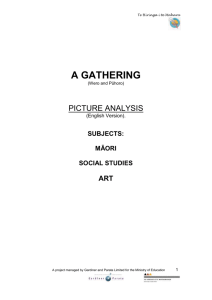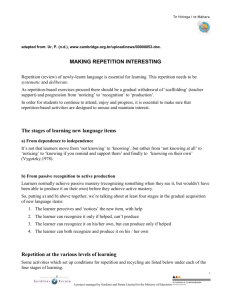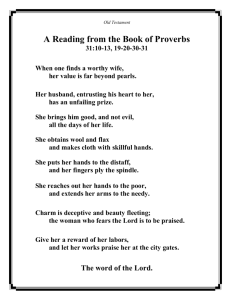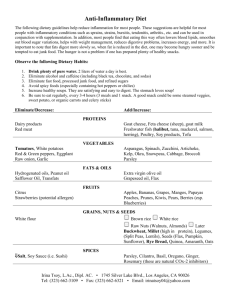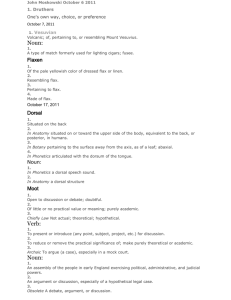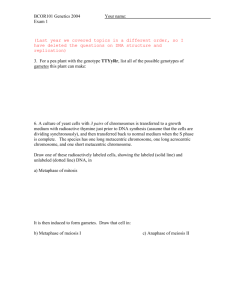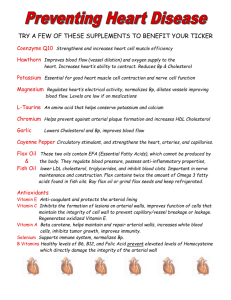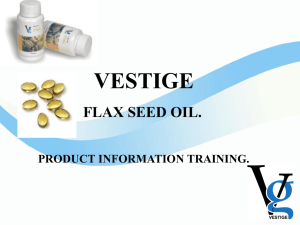Lesson Number - Te reo Māori
advertisement
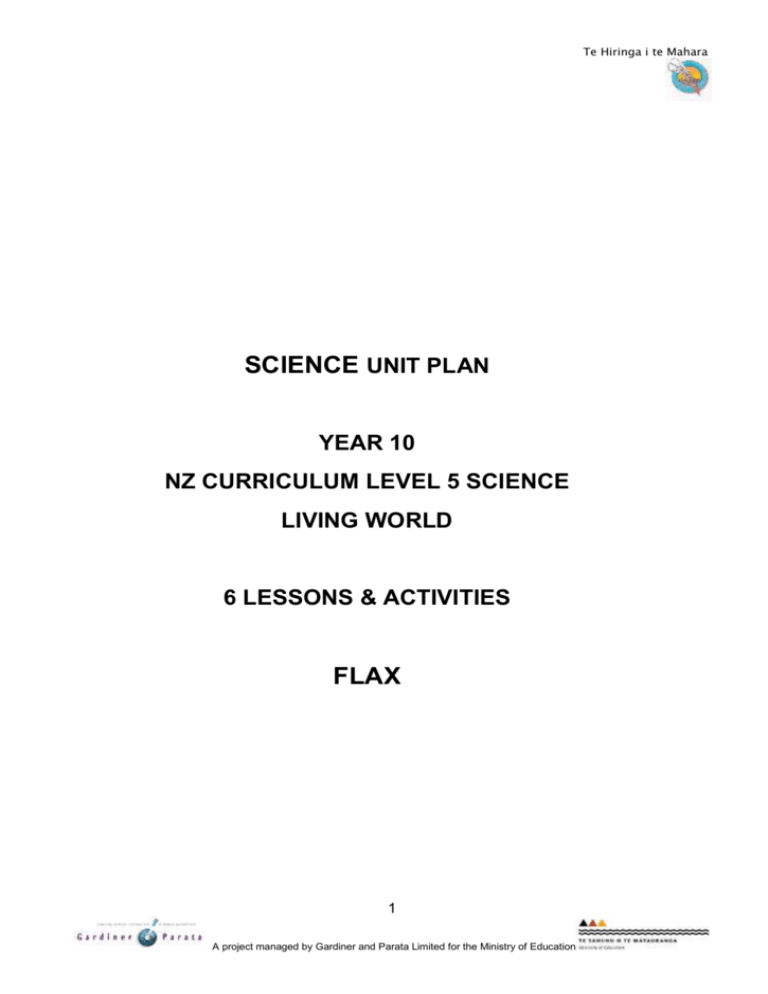
Te Hiringa i te Mahara SCIENCE UNIT PLAN YEAR 10 NZ CURRICULUM LEVEL 5 SCIENCE LIVING WORLD 6 LESSONS & ACTIVITIES FLAX 1 A project managed by Gardiner and Parata Limited for the Ministry of Education Te Hiringa i te Mahara Plan for Unit of Work – Year 10 Science – Flax Model: ALL Kaupapa Māori: Teacher knowledge: Moderate Low Essential Learning Area: Science Tāne Curriculum – Subject Science Strand: Living World Papatūānuku, Process: Life processes; Ecology Tāne, Papatūānuku. Level: 5 Title: Flax Achievement Aims & Objective(s): Students will: Hineteiwaiwa identify the key structural features and functions involved in the life processes of plants and animals; Tāne investigate the interdependence of living things (including humans) in an ecosystem; Rongomatāne use a wider range of science vocabulary, symbols and conventions. develop and carry out more complex investigations, including using models. Key Competencies: All Perspective: Physical form & function, & relationships Setting: Aotearoa; school grounds; local marae Lessons: 6 Activities: 1 Field trip – school grounds, botanical gardens or local marae. A flax community Whākawhenua - whāinga tapuwae, mihi 2. Plant parts, functions & uses. Vocab and definitions. Reo Māori Aotearoa; local marae 2 A project managed by Gardiner and Parata Limited for the Ministry of Education Te Hiringa i te Mahara Activities: 3. A closer look at community relationships. Some animal characteristics (feeding). Rangahau The characteristics of life (MRSGREN) 4. Flowers, pollination & fertilisation Tahu kōrero 5. Community interrelationships Tahu kōrero 6. Using the flax Te Hao Māori Practice: Kohinga 2 - Māori practice checklist Whāinga tapuwae, wānanga, kauhau, mihi, waiata Reo Māori: Kohinga 3 - Reo Māori checklist Single words & labels. Resources: - Kohinga 1 PM Ryan: The Reed Dictionary of Modern Māori http://teaohou.natlib.govt.nz/teaohou/issue/Mao03TeA/ c16.html New Growth From Old, J Metge, VUP, 1995 Māori Fibre Techniques, M Prendergrast, Reed, 2005 New Zealand’s Economic Native Plants, RC Cooper & RC Cambie, OUP, 1991 A Field Guide to the Native Edible Plants of New Zealand, A Crowe, Collins, 1983 http://www.interlink.org.nz/projects/poles/polesly2.html http://www.alibrown.co.nz/gathering-flax.html http://www.teachersdomain.org/resources/tdc02/sci/life /stru/beakgallery/index.html http://www.teachersdomain.org/resources/tdc02/sci/life /colt/mouths/index.html Kiwi Integrated Science Series, 3 Science Book 1, J Sweeney, D Relph, L DeLacey. New House. Kiwi Integrated Science Series, 4 Science Book 4, J Sweeney, D Relph, S Haigh, L DeLacey. New House. 3 A project managed by Gardiner and Parata Limited for the Ministry of Education Te Hiringa i te Mahara UNIT TITLE: FLAX YEAR LEVEL: Year 10 CURRICULUM DETAILS: KEY COMPETENCIES: STRAND: All Living World ACHIEVEMENT OBJECTIVES: Level 5 Students will: identify the key structural features and functions involved in the life processes of plants and animals (life processes); investigate the interdependence of living things (including humans) in an ecosystem (ecology). STRAND: Nature of Science ACHIEVEMENT OBJECTIVES: Students will: use a wider range of science vocabulary, symbols and conventions; develop and carry out more complex investigations, including using models. 4 A project managed by Gardiner and Parata Limited for the Ministry of Education Te Hiringa i te Mahara SPECIFIC LEARNING OUTCOMES: The students should be able to: identify the characteristics of life; identify and describe key structural features and their functions in maintaining survival of plants; explain the process of sexual reproduction in a flowering plant; investigate and identify interrelationships within a biological community; identify, discuss and explain some uses of flax. EXPECTED PRIOR KNOWLEDGE: Living World Level 3/4 RESOURCE REQUIREMENTS: This unit is best conducted in early summer so that the flax flowers are available. Seed pods may still be on some bushes from the previous season, or collect them for use in the following year. Access to flax bushes (or tī kōuka) and weavers/kaumātua. Supply of flax or tī kōuka leaves showing windows and notches made by the window and notch caterpillars (see photo on Activity 1 sheet of Lesson 3). Flax flowers; flax seedpods; single-edge razor blades; wooden chopping boards. Photos of flax flowers and seedpods if time of year is inappropriate. REFERENCE MATERIAL: The Reed Dictionary of Modern Māori, PM Ryan, Reed, 1995 http://teaohou.natlib.govt.nz/teaohou/issue/Mao03TeA/c16.html New Growth From Old, J Metge, VUP, 1995 Māori Fibre Techniques, M Prendergrast, Reed, 2005 New Zealand’s Economic Native Plants, RC Cooper & RC Cambie, OUP, 1991 A Field Guide to the Native Edible Plants of New Zealand, A Crowe, Collins, 1983 http://www.interlink.org.nz/projects/poles/polesly2.html http://www.alibrown.co.nz/gathering-flax.html 5 A project managed by Gardiner and Parata Limited for the Ministry of Education Te Hiringa i te Mahara http://www.teachersdomain.org/resources/tdc02/sci/life/stru/beakgallery/index.html http://www.teachersdomain.org/resources/tdc02/sci/life/colt/mouths/index.html Kiwi Integrated Science Series, 3 Science Book 1, J Sweeney, D Relph, L DeLacey. New House. Kiwi Integrated Science Series, 4 Science Book 4, J Sweeney, D Relph, S Haigh, L DeLacey. New House 6 A project managed by Gardiner and Parata Limited for the Ministry of Education Te Hiringa i te Mahara LESSON PLAN 1 TIME: 60 minutes (extra time for travel may be required) KAUPAPA MĀORI: Whākawhenua – whāinga tapuwae; mihi TEACHER INSTRUCTIONS: Make at least one preliminary trip around the school grounds or to the botanical gardens or marae for planning purposes. The venue will depend on the location of suitable flax bushes and preference of kaumātua. If the trip is to the botanical gardens, make the necessary transport arrangements. Complete school trip requirements, e.g. Risk Analysis & Management documentation; parental consent, etc. Photocopy Activity sheet. Take copies of Kiwi Integrated Science Series, 3 Science Book 1 for referral to page 38, Instruct students to have notebooks/sketchbooks and pencils with them. Delegate role of kaikōrero for mihi on behalf of the group. STUDENT INSTRUCTIONS: Complete and return documentation for trip out of school. Have a notebook or sketchbook with you on the trip. Be prepared to listen and observe well and ask thoughtful questions. Work in small groups to complete the tasks on page 38 of the text book in the time available. 7 A project managed by Gardiner and Parata Limited for the Ministry of Education Te Hiringa i te Mahara ACTIVITY Kua tupu tōu pā harakeke, kua aroha kit e pīpī nei, kit e kākā. Your flax bush has grown vigorously, It has nurtured the fledgling and the full-grown kākā. The flax bush in its maturity provides sustenance for all, young and old, small and great, with their varied needs. Listen to and talk with the people here about the flax bush and how it is cared for to ensure its survival. Read through your activity page ‘Taking a close look at flax’ that your teacher will give you. In your group, complete the tasks listed on the activity page in the time given by your teacher. These sketches and notes will be used in other lessons in this unit of work on flax. 8 A project managed by Gardiner and Parata Limited for the Ministry of Education Te Hiringa i te Mahara LESSON PLAN 2 TIME: 60 minutes KAUPAPA MĀORI: Reo Māori TEACHER INSTRUCTIONS: For Activity 1, have a photo of a flowering flax bush for any student who may have been absent from the field activity, and old seed pods available. For Activity 2, prepare charts for PAIR DEFINITIONS activity. If using the words defined in Activity 1, the charts are prepared below, or modify if other words are to be used. Photocopy enough for the number of pairs in class. Words Definitions Words Definitions Words Puawai Kakau Whā Words Akaaka Rito Puhui hua Activity 3 may be developed to involve more in-class research if time allows and there is student interest. Page 39 of KIS 3 Science Book 1 may also be used. Research at home may be followed up in later lessons. Have English-Māori/Māori-English dictionaries available for Activity 2. 9 A project managed by Gardiner and Parata Limited for the Ministry of Education Te Hiringa i te Mahara STUDENT INSTRUCTIONS: Activity 1 introduces the names of plant parts and their functions, that is the job that each does to help the survival of the plant as a whole. Activity 2 is an opportunity for you to recall your learning from Activity 1 and let you know which aspects you need to work on. Activity 3 develops your knowledge and understanding of human use of flax, both ancient and traditional use as well as more modern. 10 A project managed by Gardiner and Parata Limited for the Ministry of Education Te Hiringa i te Mahara ACTIVITY 1 Parapara waerea a ururua, Kia tupu whākaritorito te tupu o te harakeke. Clear away the overgrowth, so that the flax will put forth many young shoots. Flax bushes grow wild in swamps and wet fertile soils, and, if carefully looked after will be strong and flourish well even if cut back as they are in the plantations used by weavers. Each bush is made up of long, swordlike leaf blades that grow in fans. The roots of these fans are densely intertwined so can only be separated with a sharp spade. Growth takes place at the centre of each fan, where the new shoot (rito) is protected by the two leaves on either side (awhi rito). When gathering flax, a Māori weaver will cut only the outer blades of each fan, leaving the rito and its protecting blades so that growth can continue. The flax bush is likened to a whānau, with the rito as a child (tamaiti), emerging from and protected by its parents (mātua). The older blades (kaumātua) surround them. Each fan is part of the whānau, sharing common roots and gaining strength from being a part of a larger whole. Refer to the sketch of the whole plant that you drew last lesson, draw a simple diagram of the plant part to match its name: Name Ingoa Picture/Whākaahua Function/Mahi stem kakau Holds the leaves up towards the sun for photosynthesis and the flower heads upright for pollination root akaaka Anchors the plant in the ground and absorbs water and minerals leaf whā Makes food for the plant using carbon dioxide, water and sunlight growing tip rito New growth comes from this point seed pod puhui hua Casing that protects the seeds flower puāwai Where sexual reproduction takes place 11 A project managed by Gardiner and Parata Limited for the Ministry of Education Te Hiringa i te Mahara ACTIVITY 2 PAIR DEFINITIONS For this activity, you are going to work in pairs without your books. Your teacher will give each of you in a pair, a chart. They are not the same DO NOT show your charts to each other at this stage! Each chart consists of three columns: Words – The first column is headed “Words” and contains a list of key words; – The second column is headed “Definitions” and is left blank; Definitions Words keyword keyword keyword – The third column is headed “Words” and is left blank. Each of you will write a definition for each word listed in the first column. Then fold the paper along the dotted line between the first and second columns so that your partner will be able to see the definitions but not the original words. Swap papers with your partner and read your partner’s definitions. Now write in the third column the word that you think your partner has defined. When you have each completed the charts, open them out and compare with your partners. If you have two different words for one definition, could the two words mean the same thing? Were the definitions clear enough to indicate one particular meaning? Finally, open your books and compare your definitions. 12 A project managed by Gardiner and Parata Limited for the Ministry of Education Te Hiringa i te Mahara ACTIVITY 3 Māori used flax fibre to make many kinds of rope. After scraping, the fibre was twisted into strands by rolling on the thigh and then up to eight strands were plaited into ropes, both square and round. Weaving a rope in this way gives it great strength – the heaviest ropes were used for mooring canoes. Whāt advantage do you think the fibre in flax leaves gives to the plant? In a small group, brainstorm other uses of flax. Elect a spokesperson who will put forward your ideas to the class. Your ideas will be summarised on the board for discussion. Are there other members of your whānau who would be able to give you more ideas? 13 A project managed by Gardiner and Parata Limited for the Ministry of Education Te Hiringa i te Mahara LESSON PLAN 3 TIME: 60 minutes KAUPAPA MĀORI: Rangahau TEACHER INSTRUCTIONS: Have a supply of about 10 leaves from flax plants or tī kōuka that have been chewed by the notch and window caterpillars for Activity 1. For Activity 2, prepare slides in Bird Beak Gallery and notes from Background Essay) on bird beaks as an example structural features and functions from http://www.teachersdomain.org/resources/tdc02/sci/life/stru/beakgallery/index.html Prepare pictures in Animal Mouths and notes from Background Essay) on mouth parts as an example structural features and functions from http://www.teachersdomain.org/resources/tdc02/sci/life/colt/mouths/index.html Activity 2 could be developed into a whole lesson if appropriate for the class and teacher. STUDENT INSTRUCTIONS: For Activity 1, your teacher will organise you into groups and give you one or two leaves from flax plants or tī kōuka that have been chewed by the notch and window caterpillars for you to look at the evidence of their feeding. Measure the distance in millimetres of each window and notch from the midrib (midline running the length of the leaf) and record as a tally into a frequency table. Then contribute the group results to those of the class to draw a histogram to demonstrate that the two caterpillars are not in direct competition with each other for food. For Activity 2, your teacher will provide you with pictures of different birds’ beaks and other animals’ mouths for you to see how different animals have special adaptations of the same structure for a similar function – that is, getting food in! Discuss as a class the suitability of the beaks and mouth parts that you have seen to the food that the animal consumes. 14 A project managed by Gardiner and Parata Limited for the Ministry of Education Te Hiringa i te Mahara ACTIVITY 1 Look at these two photos - there are two separate species of caterpillar at work here, one doing the notches (called the flax notcher or noctuid) and the other the windows (called the flax looper or geometer). (Refer back to your field work in Lesson 1 and page 38 of KIS 3Science Book 1.) The flax looper has mouth parts that only allow it to scrape the plant material from the leaf blade surface, rather like you nibbling at the outside of an apple with your front teeth. Whereas the flax notcher has mouth parts that only allow it to chew the leaf blade edge, like you nibbling at a biscuit with your front teeth. The mouthparts of these two species of caterpillar allow them both to feed on the same leaf without being in direct competition for the same food source. TASK: Your group will be given a leaf of flax or tī kōuka that shows evidence of having been chewed by these two species. Your class will show that the caterpillars are not in direct competition with each other for the same food source by measuring the distance of the chew marks from the midrib of the leaf (this is the midline that you can see running the length of the leaf) and then graphing the measurements. Measure in millimetres from the closest point of the chew mark to the midrib as shown in this diagram: window measure these distances in millimetres midrib notch Record your measurements as a tally in a frequency table like this: Your teacher will set up a table on the board for each group to contribute their data and by using a different colour for each of window and notch, a histogram can be prepared to show the frequency of the distances of windows and notches from the midrib in flax leaves. distance from midrib (mm) windows 0-4 II 5–9 IIII 10 - 14 and so on 15 A project managed by Gardiner and Parata Limited for the Ministry of Education notches Te Hiringa i te Mahara LESSON PLAN 4 TIME: 60 minutes KAUPAPA MĀORI: Tahu kōrero TEACHER INSTRUCTIONS: Photocopy Activity sheets 1, 2 & 3. Have blank A4 paper available for Activity 1. Prepare 7 slips of paper with one of the seven characteristics of life written on each (Movement; Respiration; Sensitivity; Growth; Reproduction; Excretion; Nutrition). Have English-Māori/Māori-English dictionaries available. Have available a supply of flax flowers, single-edge razor blades and wooden boards. STUDENT INSTRUCTIONS: Your teacher will organise you into groups to complete the MRSGREN tasks in Activity 1. Read about the structures involved in pollination and plant sexual reproduction in Activity 2. In Activity 3, you will carry out a practical investigation of the structure of a flax flower and identify the parts. 16 A project managed by Gardiner and Parata Limited for the Ministry of Education Te Hiringa i te Mahara ACTIVITY 1 He puāwaitanga nō te harakeke; he rito whākakī I ngā whāruarua. The flax flowers; new shoots fill the empty gaps. The flowering of the flax is an awesome sight with each bush producing long flower stalks. The red and yellow flowers at their ends tower over the rest of the plant. These stalks displace the rito at the centre of the fans leading to the decay of the fans and empty gaps but the process of flowering stimulates the plant to produce new fans. Producing flowers not only promotes growth in the parent flax plant but will also start the process of sexual reproduction that will lead to the production of seeds which will germinate to produce new flax plants if they arrive at a location that offers the right conditions. Reproduction is ONE of SEVEN characteristics of life, i.e. all living things show these characteristics. MRS GREN, who you have met before, helps us remember these. Use the words listed to remind you of how MRS GREN does this: M excretion movement growth respiration sensitivity nutrition R S G R E N reproduction Your teacher will put your class into seven groups, giving each group 2 sheets of A4 paper, and one of MRSGREN’s characteristics of life. In your group: 1. On one sheet draw a concept circle (see below) with your word in one quadrant. growth 2. Use the other sheet for the group members to brainstorm related words that could be used to make a sensible sentence. 3. Choose three of the brainstorm words and write each into a quadrant of your circle. 4. Write a sensible sentence on the reverse side of your brainstorm sheet, using your four keywords. 5. Pass the concept circle sheet onto the next group on your left, and receive the concept circle from the group on your right. 17 A project managed by Gardiner and Parata Limited for the Ministry of Education Te Hiringa i te Mahara 6. Use their four keywords, write a sensible sentence on the reverse of your brainstorm sheet. 7. Repeat the passing on of concept circles and writing sentences until your original concept circle comes back to you. 8. While you are completing the next activity, your teacher will check your sentences. 18 A project managed by Gardiner and Parata Limited for the Ministry of Education Te Hiringa i te Mahara ACTIVITY 2 Look at these pictures of the flax flower and the tui. The flower of the flax is pollinated by the tui (so this bird is a pollinator) – look at the shape of the tui’s beak. Its length and shape allow it to reach the nectar at the bottom of the flower. The pollen (male sex cell) of the flax flower is on end of stamens (the male part of the flower). The tui has got the yellow pollen on its feathers just above its beak. It stuck there when the tui pushed its beak down into the flower to get to the nectary (produces sweet nectar to attract birds and insects that feed on it). When the tui visits another flax flower, the pollen will be transferred onto the sticky stigma (female part of the flower) which is in the centre of the cluster of stamens. The pollen will grow down from the stigma to the ovary beneath and fertilise an ovule (female sex cell) and develop into a seed. Many pollen grains will fertilise the many ovules in the ovary, developing into many seeds which will be encased by a seed pod (this was the ovary). Look at the photos below of seed pods on flax plants. When the seeds are mature and the seed pod dried, it will suddenly burst open and release its seeds which will be dispersed (scattered and carried) away from the parent plant. The tui and flax have a relationship which benefits both. This is called mutualism. Identify the benefit to the tui. Identify the benefit to the flax. 19 A project managed by Gardiner and Parata Limited for the Ministry of Education Te Hiringa i te Mahara ACTIVITY 3 Your teacher will provide you with a flax flower, razor blade and wooden board. You are going to carry out a dissection of the flower to identify the parts described in Activity 2. 1. Before you start the dissection, identify these parts which can be seen from the outside of the flower: a. Petals (coloured to attract the pollinator, they protect the inner sexy bits); b. Sepals (at the base of the petals, they have protected the developing flower before it blossomed); c. Stamens with yellow pollen grains on the ends; d. Stigma in the centre of the ring of stamens. 2. Cut the flower in half lengthwise. 3. Identify these parts: a. the stamens (anthers where the pollen is, and filaments are the stalks that hold the anthers up in the air); b. the stigma which is on top of the long tube-like structure called the style; c. the ovary at the base of the style; d. the nectary around the base of the ovary. 4. Cut open the ovary and look at the ovules (developing seeds). 5. Draw and label the flax flower, both inside and out. 6. Use your observations to complete the table below listing the numbered parts of the flower diagram alongside. 1 2 3 4 5 6 7 8 20 A project managed by Gardiner and Parata Limited for the Ministry of Education Te Hiringa i te Mahara LESSON PLAN 5 TIME: 60 minutes KAUPAPA MĀORI: Tahu kōrero TEACHER INSTRUCTIONS: Have available copies of Kiwi Integrated Science Series, 3 Science Book 1 for referral to page 38 and student work from Lesson 1. Have English-Māori/Māori-English dictionaries available. STUDENT INSTRUCTIONS: Use information that you have collected and whāt you have learned in earlier lessons to complete the tasks about the interdependence of different species in a community. 21 A project managed by Gardiner and Parata Limited for the Ministry of Education Te Hiringa i te Mahara ACTIVITY 1 Hutia te rito o te harakeke, kei whea te kōmako e kō? Ka rere ki uta, ka rere ki tai. If you pluck out the flax shoot, where will the bellbird sing? fly inland. It will fly seawards, it will If you stop the flax bush growing, there will be no nectar-laden flowers to attract birds and no flower stalks for them to perch on. They will fly distractedly to and fro looking for food and a resting place. This whakataukī reminds us that living things depend upon each other for their well-being. The members of a community are linked together in a complicated way, competing for space and other resources, especially food. Food chains show how living things in a community depend on each other for food. They can be built up according to the way that the living things obtain their food. The different groups are: PRODUCER HERBIVORE CARNIVORE which traps energy from the sun to make food from inorganic chemicals which eats the producer and gets energy from it which eats the herbivore and gets energy from it In some communities there may be a type of carnivore that feeds on another, e.g. a cat feeding on a bird that has fed on an insect that chewed on grass. The grass is a producer The insect that chews on grass is a herbivore The bird that eats the insect is a first level carnivore The cat that eats the bird is a second level carnivore Decomposers are bacteria and fungi and they feed on any plant or animal that dies so can be involved at any level in the community. 22 A project managed by Gardiner and Parata Limited for the Ministry of Education Te Hiringa i te Mahara Using the information that you collected from the field activity in Lesson 1 (or refer to page 38 in KIS 3Science Book 1), work out a food chain based on the community that lives on a flax bush and write it out in the space below in red. In most communities, it is possible to build up many food chains. You can demonstrate this by working out at least two more food chains for the flax bush community and write them out in the space below: write one in green and write the other in blue. By combining these food chains together a food web is produced. A food web is a complete picture of the feeding links in a community. It is often very difficult to build up a complete food web as some animals may be hard to find or it may not be easy to work out whāt some animals eat. Using the coloured food chains that you have identified, combine them into a food web, keeping the colours so that you can still easily identify the individual food chains. This is an example of a food web from a different community with some of the food chains coloured as a model for your flax bush food web. cricket grass aphid manuka lacewing praying mantis leaf hopper thrush cat spider There are 4 food chains in this food web. Can you identify them all? Go back to your information sheet. Can you identify any further food chains to add to your food web? 23 A project managed by Gardiner and Parata Limited for the Ministry of Education Te Hiringa i te Mahara ACTIVITY 2 Look at the food web from Activity 1: cricket grass aphid manuka lacewing praying mantis leaf hopper thrush cat spider If a gardener sprayed their garden to kill the aphids because they were affecting his roses, whāt do you think would happen to this food web which is also part of his garden? Think carefully about the short-term and long-term effects. Write a paragraph explaining the possible consequences of the gardener’s actions. _________________________________________________________________________ _________________________________________________________________________ _________________________________________________________________________ _________________________________________________________________________ _________________________________________________________________________ _________________________________________________________________________ _________________________________________________________________________ _________________________________________________________________________ _________________________________________________________________________ _________________________________________________________________________ 24 A project managed by Gardiner and Parata Limited for the Ministry of Education Te Hiringa i te Mahara LESSON PLAN 6 TIME: 60 minutes KAUPAPA MĀORI: Te Hao TEACHER INSTRUCTIONS: Make at least one preliminary trip to the marae or workplace of the weaver for planning purposes. Some activities that would help reinforce previous lessons as well as extend understanding of tikanga: - Care of plants; - Preparation of leaves; - Different uses; - Weaving. Make the necessary transport arrangements. Complete school trip requirements, e.g. Risk Analysis & Management documentation; parental consent, etc. Delegate role of kaikōrero for mihi on behalf of the group. STUDENT INSTRUCTIONS: Complete and return documentation for trip out of school. Be prepared to listen, observe and take part well in offered activities, and ask thoughtful questions. 25 A project managed by Gardiner and Parata Limited for the Ministry of Education
